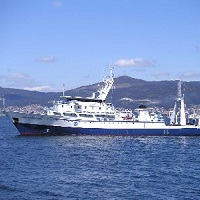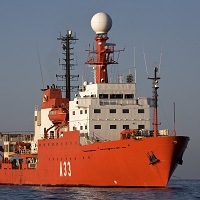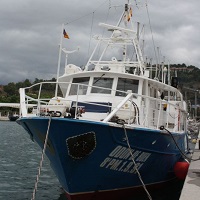Keyword
Cartagena
63 record(s)
Type of resources
Categories
Topics
INSPIRE themes
Keywords
Contact for the resource
Provided by
Years
Formats
Status
-

The MEDITS survey (International bottom trawl survey in the Mediterranean is organized to monitor the demersal resources in the Mediterranean. It intends to produce relevant information to support the fishery policy by collecting abundance data and biological parameters of fish, crustaceans and cephalopods species. The hauls are positioned following a depth stratified sampling scheme with random drawing of the positions within each stratum. The hauls are made in the same position from year to year. The following depths are fixed in all areas as strata limits : 10 - 50 m, 50 - 100 m, 100 - 200 m, 200 - 500 m, 500 - 800 m. The protocols, including the specifications of the standard gear are described in an instruction manual. The series began in 1994 with one yearly survey. Ten Mediterranean countries are applying the Medits protocols (about 1100 hauls per year).
-

- Levantamientos hidrograficos sistematicos y exhaustivos que permitan el cartografiado total de sus fondos\n- Exploracion geofisica que permitan determinar su xonstitucion y fisiografia\n- Estudio de los procesos fisicos\n- Procesar y tratar los datos obtenidos para la obtencion de mapas, cartas e informes en los cuales se definan las caracteristicas
-

- Levantamientos hidrogr??ficos sistem??ticos y exhaustivos que permitan el cartografiado total de sus fondos - Realizar exploraciones geof??sicas que permitan determinar su constituci??n y fisiograf??a - Llevar acabo coampa??as oceanogr??ficas sistemat??cas para el estudio de los procesos f??sicos - Procesar y tratar los datos obtenidos en las campa??as para la obtenci??n de mapas, cartas e informesen los cuales se definan las caracteristicas y el potencial economico de la ZEE - Hacer tratamiento inform??tico necesario para la integraci??n de datos en bancos de datos interactivos. - Poner a disposici??n de la comunidad cientifica e industrial toda la informacion, salvo la restringida por afectar a la seguridad nacional.
-

Estudiar la viabilidad así como optimizar, en su caso, un sistema de observación multidisciplinar en el Mediterráneo español, incluyendo la medida de gases de efecto invernadero
-

Multidisciplinary monitoring of the Spanish Mediterranean waters
-

Multidisciplinary monitoring of the Spanish Mediterranean waters. 1º PART- 13/11/2010 - 20/11/2010 2º PART 16/12/2010 - 22/12/2010
-

Multidisciplinary monitoring of the Spanish Mediterranean waters
-

- Exploraciones geofisicas que permitan determinar su constitucion y fisiografia\n- Estudio de procesos fisicos\n- Procesado y tratamiento de datos, para la obtencion de mapas, cartas e informes\n- Estudio de batimetria, geomorfologia, gravimetria, magnetometria y calidades de sedimentos superficiales de las zonas estudiadas
-
The overall objective of the cruise was to identify the pathways of sediment transfer from the conjugate margins of Algeria and of the Balearic Promontory to the Algerian Basin from the Early Pliocene flooding of the Mediterranean to the Present.The cruise is the result of a co-operation between the University of Barcelona and OGS within HERMES (Hotspot Ecosystems Research on the Margins of European Seas) Integrated Project.The proposed research complies also with the objectives of the Collaborative Research Programme ESF-EUROCORES on EUROMARGINS 'WEST-MED' and 'SPACOMA'. The survey has been planned in order to fill the bathymetry among existing data sets:- Spanish EEZ project (Instituto Espa?ol de Oceanografia and Instituto Hidrografico de la Marina);- The BALCOM Project (Instituto Espa?ol de Oceanografia);- And the MARADJA Project (Universite de Bretagne Occidentale and IFREMER).In addition the survey area covers the track of multichannel seismic profile MS-46 acquired by OGS in 1972.The cruise went very smoothly, helped by excellent weather conditions and proper functioning of the instrumentation. Departure from Palma on Sep 20 15:50. Begin of multibeam and chirp sonar survey the same day at 20:00. Start of multichannel seismic survey on Sep 27 at 17:45. End of operations on Sep 29 at 24:00. Arrival in Cartagena on Sep 30 at 12:00.
-

- Levantamientos hidrograficos sistematicos y exhaustivos que permitan el cartografiado total de sus fondos\n- Realizar exploraciones geofisicas que permitan determinar su constitucion y fisiografia \n- Llevar acabo coampa?as oceanograficas sistematicas para el estudio de los procesos fisicos\n- Procesar y tratar los datos obtenidos en las campa?as para la obtencion de mapas, cartas e informesen los cuales se definan las caracteristicas y el potencial economico de la ZEE\n- Hacer tratamiento informatico necesario para la integracion de datos en bancos de datos interactivos.\n- Poner a disposicion de la comunidad cientifica e industrial toda la informacion, salvo la restringida por afectar a la seguridad nacional.\n
 Catálogo de datos del IEO
Catálogo de datos del IEO